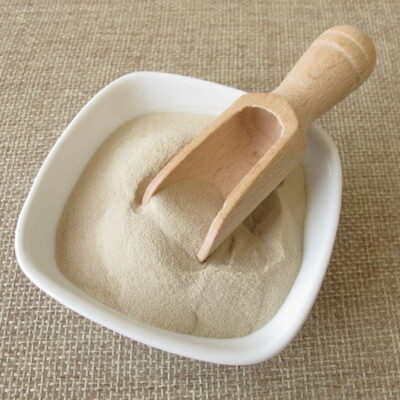Origin
Legend has it that a small town innkeeper in Japan offered a seaweed jelly to a visiting Emperor in the 17th century. Some of the jelly was not eaten and thrown away. The innkeeper found it frozen the next morning and discovered that it was now a low density, crumbly cracked substance that could be reheated to form jelly once more.1
Industrialization of agar in its dry stable form began in the 18th century and was called kanten in Japan. Agar-agar is of Malayan origin and agar is the most widely accepted name, however, it is also known gelosa in French and Portuguese speaking countries.
Nutrition
Since only a small amount is used in recipes, it’s likely to only have a minor effect on the overall nutritional quality of the final product.
Nutrition per 100 grams:2
| kCal | 306 |
| Protein | 6.2 gm |
| Fat | 0.3 gm |
| Carbohydrate | 80.9 gm |
| Fiber | 7.7 gm |
| Sugars | 3.0 gm |
| Calcium | 625 mg |
Commercial production
Different red algae seaweeds from the Rhodophyceae class can be utilized to make agar. Currently the industry uses the following seaweeds for production:1
- Gelidium (original source of genuine agar)
- Gracilaria
- Pterodadia Capillace
- Gelidiella
Seaweed can be gathered at shore, cut from beds or cultivated. Once it is harvested, it is cleaned, dehydrated, pressed and then extracted for the polysaccharides agarose and agaropectin. Methods of extraction vary. After extraction, it is frozen, dried, milled and screened for use.
Function
- A 1.5% solution will be clear and forms a firm gel after boiling and cooling to 34-43°C. This gel is strong and will not melt below 85°C.1
- This gelling power allows the addition of agar to gluten-free baking formulations to provide desirable viscoelastic properties.
- Similar to other seaweed hydrocolloids, agar can improve dough stability, reduce staling and extend shelf life of baked products.
Application3
Icings:
- Water-based (for wrapped and unwrapped baked goods). Boil agar (0.35%) in sugar-water solution, then add this mixture to the icing sugar. Apply icing hot at 50-60°C.
- Fat-based (for cakes). Dry blend agar (0.5%) with salt, emulsifiers, dextrose, starch and sugar, mix into creamed fat based cake icing and heat the entire mixture to 48 °C while mixing.
Fillings:
- Suspend agar (200 grams) in cold water, add 10 fruit pulp (10 Kg) and sugar (10 Kg). Boil for 10-15 minutes.
Regulation
In the EU, agar is approved as a food additive (E 406), but is not allowed for the manufacture of jelly mini-cups because these candies may pose a choking hazard.4 In the U.S., agar is considered safe for use in frostings up to 2% and in baked goods up to 0.8% (21 C.F.R. § 184.1115 2018).
References
- McHugh, D.J. Production and utilization of products from commercial seaweeds. FAO Fish.Tech.Pap., 1987.
- USDA ARS. “Seaweed Agar, Dried”. Food Composition Database, https://ndb.nal.usda.gov
- Santos, G. “Agar and Agarose Applications”, A Manual for the Processing of Agar from Gracilaria. 1990. http://www.fao.org/docrep/field/009/ag156e/AG156E03.htm
- EFSA Panel on Food Additives and Nutrient Sources added to Food. “Revaluation of Agar as a Food Additive”, EFSA Journal, 2016. https://doi.org/10.2903/j.efsa.2016.4645

